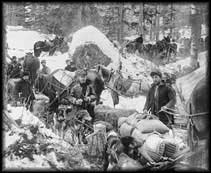The Klondike Gold Rush
On August 16, 1896 Yukon-area Indians Skookum Jim Mason and Tagish Charlie, along with Seattleite George Carmack found gold in Rabbit Creek, near Dawson, in the Yukon region of Canada. The creek was promptly renamed Bonanza Creek, and many of the locals started staking claims. Gold was literally found all over the place, and most of these early stakeholders (who became known as the "Klondike Kings") became wealthy.
Since the Yukon was so remote, word of this find spread relatively slowly for almost a year. On July 17, 1897, eleven months after the initial discovery of gold, the steamship Portland arrived in Seattle from Dawson with "more than a ton of gold", according to the Seattle Post-Intelligencer. With that pronouncement, the Klondike Gold Rush was on!
Within six months, approximately 100,000 gold-seekers set off for the Yukon. Only 30,000 completed the trip. Many Klondikers died, or lost enthusiasm and either stopped where they were, or turned back along the way. The trip was long, arduous, and cold. Klondikers had to walk most of the way, using either pack animals or sleds to carry hundreds of pounds of supplies. The Northwest Mounted Police in Canada required that all Klondikers bring a year's worth of supplies with them. Even so, starvation and malnutrition were serious problems along the trail. The story of the Klondiker who boiled his boots to drink the broth was widely reported, and may well have been true. Cold was another serious problem along the trail. Winter temperatures in the mountains of northern British Columbia and the Yukon were normally -20 degrees F., and temperatures of -50 degrees F. were not unheard of. Tents were usually the warmest shelter a Klondiker could hope for.
An even larger problem was the trails themselves. Klondikers had two choices: the Chilkoot Trail or the White Pass Trail. The White Pass Trail originated in Skagway, Alaska, where Jefferson "Soapy" Smith, a con-man from Denver, had taken over the town. Smith had set up operations in a saloon/casino called Jeff's Place and led a gang of 300 men, whom he referred to as his "lambs" to fleece Klondikers arriving to take part in the gold rush. He also perpetrated the first telegraph scam in Alaska. Smith put up poles and wires, but they weren't actually connected to anything. Nevertheless, he took cash from Klondikers eager to wire home. Things quieted down after the death of Soapy Smith in a shoot-out in July 1898. The Chilkoot Trail, which originated in Dyea a short distance from Skagway, wasn't a better option, although it had fewer outlaws. It was steeper than the White Pass Trail, and few were fully prepared for how difficult it was. Some men reportedly also went insane on the trail. Many suffered malnutrition and/or died along the trails. Some Klondikers became sick or died from eating the meat of the dead horses found on the White Pass Trail. Since almost every horse on the trail died from the terrible conditions and lack of care, it became known as the "Dead Horse Trail."
At the height of the gold rush in the summer of 1898, the Klondike region had a population of 30,000, of whom close to 17,000 lived in Dawson. At first it was a tent city, crowded and unsanitary, but by the middle of 1899, after two serious fires, it became a bona-fide city, with more amenities than one might imagine. Dawson had fire hydrants on the streets, and electric lights. People also felt safe in Dawson. The Northwest Mounted Police kept order in Canada, and nefarious characters such as Soapy Smith were not allowed entry. The growth of Dawson was largely responsible for the creation of the Yukon Territory as a new Canadian Territory on June 13, 1898.
Nor was Dawson the only Canadian city to have dramatic growth due to the Klondike Gold Rush. Vancouver, British Columbia saw its population double, and in Alberta, Edmonton's population tripled.
The Klondike Kings quickly became very rich. It is estimated that over one billion dollars worth of gold was found, adjusted to late 20th century standards. Others found their fame and fortune in different manners. Jack London became well-known by writing of his experiences in the Klondike. Nor were the successful Klondikers limited to men. Belinda Mulroney became wealthy by running a hotel and selling supplies. Many women found their riches running dance halls. Martha Black bought a sawmill and went on to become Canada's second female Member of Parliament. Even some those who didn't travel to the Klondike managed to get rich from the Gold Rush. Over 1,000 miles away, Seattle businesses made over $1 million (not adjusted) selling the needed food and supplies for the trip to the gold fields. Seattle mayor W.D. Wood should have stayed in Seattle and taken advantage of the wealth the Klondikers brought to the city. Instead, he resigned his post as mayor and set off for the Yukon. He was one of the many who turned back.
Unfortunately for those who did make it as far as the Klondike, few found the hoped-for riches. By the time the masses arrived, all the creeks had been claimed, and the new arrivals found they had to work for the Klondike Kings, rather than for themselves. The pay was not bad, ranging from $1-10 per day, but this was not what the Klondikers had made the trip for. Many Klondikers never recouped the cost of the trip, which averaged $1200 (not adjusted). Nevertheless, when gold was discovered at Nome, Alaska in 1899, few of these Klondikers stopped to think about what they had just experienced. At the first sign of gold, much of Dawson up and left for Nome, where most of the gold-seekers once again lost out on finding fame and fortune.
Published February 4, 2002




